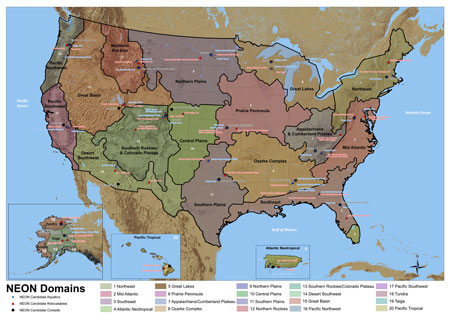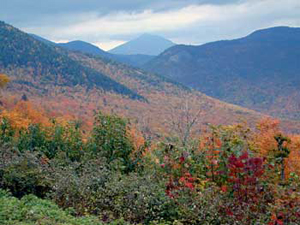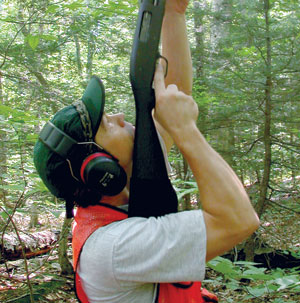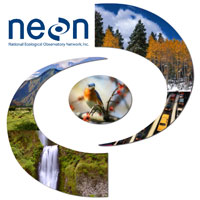When groundbreaking ceremonies take place tomorrow (June 8) at Harvard Forest in Petersham, Mass., ecologists around the nation, including those at the University of New Hampshire, will be one step closer to seeing the National Ecological Observatory Network (NEON) become a reality.
|
NEON will build and link together 62 sites in 20 regional "eco-climatic domanis" across the country. Photo courtesy of NEON. |
And it is a big reality indeed. When completed in 2016, NEON will be the National Science Foundation’s continental network of data-gathering stations funded to the tune of $433 million by the federal Major Research Equipment and Facilities Construction program – the same pot of money that has created several astronomical observatories as well as oceanographic vessels and other big-ticket items needed to advance science in the United States.
|
Bartlett Experimental Forest in New Hampshire's White Mountains Photo courtesy of U.S. Forest Service. |
But unlike astronomers, notes UNH terrestrial ecologist and NEON board member Scott Ollinger of UNH’s Institute for the Study of Earth, Oceans, and Space (EOS), “Ecologists don’t need one big telescope, they need a large network of little ones because ecosystems are so complex and variable in both space and time. And having sites functioning as a single, highly coordinated unit will enable scientists to conduct continental-scale ecology in a way that hasn’t previously been possible.”
So in order to see the forest for the trees, NEON will build and link together 62 sites in 20 regional “domains” across the country and, for starters, make over 250 crucial measurements in their surrounding ecological systems.
In the Northeast, NEON observatories will be built at Harvard Forest, the Bartlett Experimental Forest in New Hampshire’s White Mountains – both sites where UNH scientists have conducted long-term experimental research –and another site in Burlington, Mass., representative of urban land use. Groundbreaking at two other NEON sites – the Ordway-Swisher Biological Station in Florida and the Central Plains Experimental Range in Colorado – will also occur this summer. The first three sites are expected to begin streaming data in late 2013 and be in full operation by 2014.
|
|
A vital functions monitor for the U.S. landscape
Eventually, measurements of plants, soils, organisms, and aquatic ecosystems will be collected using a multi-tiered approach involving instrument towers, distributed field plots, and aircraft remote observation platforms that will collect state-of-the-art image data for the landscape surrounding each site. Data for each site will be gathered in precisely the same fashion using precisely the same equipment over the same span of time. It will be the equivalent of hooking the U.S. landscape up to a giant vital functions monitor.
“NEON came out of this notion that what we really need is a distributed network of sensors that will continually monitor the pulse, composition, and function of ecosystems around the country,” notes Ollinger, a professor in the EOS Earth Systems Research Center (ESRC) and the department of natural resources and the environment who has been involved in the planning of NEON for more than 10 years. The network will eventually provide scientists with the capacity to understand aspects of ecosystems that heretofore have been impossible through conventional, disparate approaches, and will allow for timely monitoring of large-scale changes in the environment.
|
Courtesy of Kristi Donahue, UNH-EOS |
For example, one of the important roles NEON will fill is keeping a finger on the pulse of ecological shifts wrought by climate change such as species distribution, biogeochemical cycles, the spread of invasive species and vector-borne diseases.
“We don’t have anything in place right now that would adequately detect these changes at the spatial and temporal scales over which they will occur,” Ollinger says. Indeed, currently, if there were a severe climate event that affected the entire country, it would take years to conduct a meaningful analysis and scientists would still gain only a limited picture of the effects on ecosystems. Data would have to be cobbled together from work being done by individual researchers scattered around the country. With the integration of measurements and open data policy that define NEON, “we’ll be able to do meaningful analysis a week after such an event,” Ollinger notes.
In addition to construction beginning at Harvard Forest, this summer a series of test flights for new NEON aircraft instruments is scheduled to occur over both the Bartlett and Harvard forests. Ollinger has conducted long-term research at Bartlett using aircraft instruments to “read” leaf chemical content – data which are then compared with leaf samples shot from the forest canopy and analyzed in a lab back at UNH.
Ollinger was part of the NEON design consortium, served on the NSF panel that reviewed the network, and is serving his second term on the NEON board of directors. Additionally, John Aber (formerly of ESRC and now UNH provost) and Professor Serita Frey of the department of natural resources and the environment have also played an active role in the planning process. “UNH has been involved in NEON as much as any university pretty much from day one,” Ollinger says.
Originally published by:
UNH Today
Written by David Sims, UNH Institute for the Study of Earth, Oceans, and Space





















































 Scott Ollinger shoots leaves from the canopy of trees in the Bartlett Experimental Forest. Leaf chemistry is analyzed and combined with "hyperspectral" remotely sensed images to provide an accurate gauge of forest productivity. Photo courtesy of Scott Ollinger.
Scott Ollinger shoots leaves from the canopy of trees in the Bartlett Experimental Forest. Leaf chemistry is analyzed and combined with "hyperspectral" remotely sensed images to provide an accurate gauge of forest productivity. Photo courtesy of Scott Ollinger.